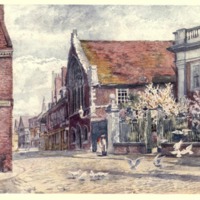Description
Marcus Huish, writing in 1907, provides a rather discerning appraisal of the state of Boston Town Hall which he laments is rented ‘to a dealer in second-hand furniture, the whole place being in consequence squalid and dirty’. Nonetheless, Elizabeth Chettle (the illustrator for Huish's book) provides some captivating illustrations of the exterior and the cells where the separatists were confined. Huish comments:
"As Bradford has told us, on their arrival at Boston they were one and all clapt into ward. This would undoubtedly be in the cells under the Town Hall, the building in which they would also be brought up for examination. As will be seen from Miss Chettle's water-colour, this building has, independently of the associations connected with it, considerable architectural interest. Its interior is equally interesting: a room which is lit by the large decorated window on the street front is a fine one; and there are others, one containing a good portrait of a municipal dignitary; also an old staircase and kitchen on a level with the cells, quaint and curious, with great old iron jacks at the large hearth. But no attempt has apparently been made to rescue it from decay and ultimate destruction, and it is let by the governors of the Boston Grammar School, to whom it belongs, for 30 a year. The cells, which are evidently in the same structural condition as they were when the unfortunate Puritans were clapt into them, are in a ruinous state. Seven of the principals were here kept in ward beyond the month, and these included Brewster, who suffered not only the loss of much goods, but also of his store of books. What happened when they came up for trial has not been recorded, but as Brewster is heard of two years later in Holland their sentences may not have been severe."


